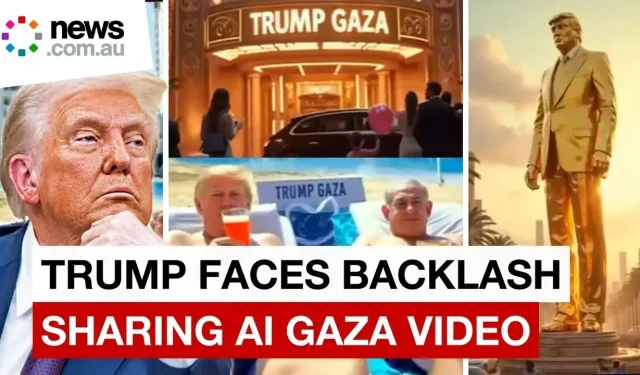Former U.S. President Donald Trump has recently faced significant backlash due to an AI-generated video he posted depicting Gaza as a luxurious beach resort. The video controversially portrays a fabricated version of Gaza, complete with belly dancers and a striking golden statue of Trump himself, completely erasing the current humanitarian crisis affecting its residents. This article delves into the implications of Trump’s video, the reactions from Gazans, and the larger conversation surrounding the use of AI in political discourse.
The Inaccurate Representation of Gaza
Trump’s AI video presents an idealized vision of Gaza, removing the stark realities faced by its inhabitants. By depicting the region as a pristine resort, the video trivializes the ongoing conflict and humanitarian struggles in the area. Such representations can perpetuate stereotypes and minimize the global understanding of the situation, especially among those unfamiliar with the actual conditions in Gaza. By excluding the harsh realities and the voices of the people living there, the video risks creating a dangerous narrative, one that neglects the suffering of countless individuals.
Furthermore, this video raises questions regarding the ethics of using advanced technology, like AI, to create misleading representations of sensitive geopolitical issues. The use of AI in media has grown exponentially, and as it becomes more accessible, the potential for misuse increases. Trump’s video serves as a case study of the possible manipulation of digital tools to influence public perception and opinion. The online backlash illustrates a growing awareness and concern about how technology might distort reality.
Cultural Reactions and Backlash
The reaction from Gazans and the global community has been overwhelmingly negative. Many viewers expressed their outrage over the trivialization of their plight through social media. The juxtaposition of festive activities like belly dancing against a backdrop of suffering struck many as a grotesque mockery of their lived experiences. Human rights activists have condemned the video as a form of cultural insensitivity, arguing that it amplifies pain without acknowledging the context of conflict and loss.
The backlash illuminates the broader societal impact of high-profile figures using their platforms irresponsibly. As someone with significant political influence, Trump’s portrayal of Gaza not only alters perceptions but may also sway public opinion away from understanding the complexities involved in the Israeli-Palestinian conflict. This incident highlights the importance of responsible media consumption and accountability when it comes to public figures and their messages.
The Role of AI in Political Discourse
This incident showcases a larger trend where technology, particularly AI, is intersecting with political narratives in alarming ways. As AI-generated content becomes more sophisticated, distinguishing between fact and fiction is increasingly difficult. This development poses critical challenges for voters and citizens trying to navigate misinformation. It also raises ethical questions about the responsibility of those who wield these digital tools: Is it justifiable to use AI to create fictional narratives that detract from real human experiences?
While technology can be a powerful means to inform and engage audiences, it also holds the potential to mislead. This delicate balance calls for more diligent consideration of how digital media is consumed, shared, and scrutinized. As conversations about regulation and ethical standards for AI continue, incidents like Trump’s controversial video serve as reminders that the ramifications of these technologies can extend far beyond entertainment into the fabric of societal understanding and discourse.
Conclusion
In a world increasingly defined by rapid technological advancements, Trump’s AI-generated video of Gaza serves as a cautionary tale about the potential misuses of media. It invites us to critically examine both the narratives being pushed by influential figures as well as the tools utilized to craft them. As we reflect on these events, one must consider: How can society better hold public figures accountable for their representations, especially when the stakes are as high as human dignity and cultural integrity?
https://www.youtube.com/watch?v=J35DVxv49gw


